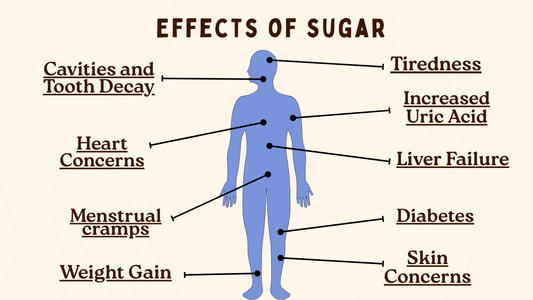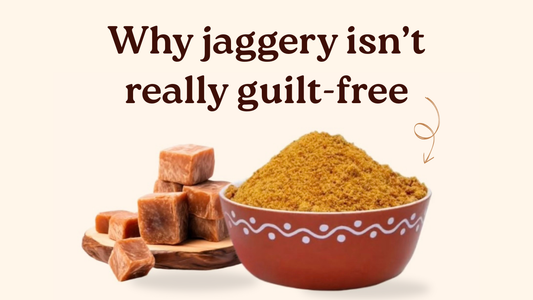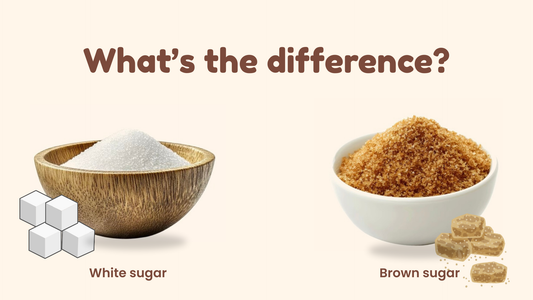Why This Confuses People
“Sugar is sugar, right?” That’s what most people think. But here’s the thing - not all sugar is the same. The sugar you get from an apple is not the same as the sugar in a candy bar. One comes packaged with fiber, vitamins, and minerals. The other is stripped down, concentrated, and hits your bloodstream like a freight train.
This confusion is why many people wrongly avoid fruits or think “natural” sugar on a label means safe. Let’s clear it up once and for all: natural sugar vs added sugar - what’s the difference, and what does your body really see?
What Is Natural Sugar?
Natural sugars are those that occur naturally in whole foods.
• Fruits → Contain fructose and glucose, but always bundled with fiber, water, vitamins, and antioxidants.
• Milk and dairy → Contain lactose, along with protein, calcium, and fat.
• Vegetables → Contain small amounts of sugars, but also high in fiber and nutrients.
Why Natural Sugars Are Different?
• Fiber slows digestion → prevents rapid blood sugar spikes.
• Nutrients support overall health.
• Satiety factor → Whole fruits fill you up, candy does not.
• Antioxidants fight inflammation and oxidative stress.
👉 Example: Eating an apple (natural sugar + fiber) digests slowly, keeping blood sugar stable. Drinking apple juice (squeezed sugar water, no fiber) spikes your glucose instantly.
What Are Added Sugars?
Added sugars are any form of sugar put into food or drinks during processing or preparation.
Examples:
• Table sugar (white/brown)
• High-fructose corn syrup
• Honey (yes, even though it’s natural, when added it counts as added sugar)
• Jaggery, syrups, molasses, coconut sugar
• Sugars hidden in packaged foods (sauces, breads, flavored yogurts, juices)
Why Added Sugars Are a Problem?
• Provide empty calories (no nutrients, just energy).
• Cause rapid blood sugar and insulin spikes.
• Linked to obesity, type 2 diabetes, fatty liver disease, and heart problems.
• Often added in hidden ways - “no added sugar” labels can still be misleading.
Does Your Body See a Difference?
Here’s the important truth:
• Molecule by molecule, sugar is sugar. Glucose is glucose. Fructose is fructose.
• But the context matters.
Natural Sugar in Whole Foods
When sugar is eaten inside fruit, milk, or vegetables:
• Comes with fiber and nutrients → slows absorption.
• Makes you feel full → reduces overeating.
• Has a protective effect on health → whole fruit intake is linked with lower risk of diabetes and heart disease.
Added Sugar in Processed Foods
When sugar is eaten as soda, candy, cookies:
• No fiber → rapid absorption → blood sugar spikes.
• Easier to overconsume → liquid calories don’t make you feel full.
• Directly linked with metabolic diseases.
👉 So while chemically the sugars are the same, your body responds very differently based on whether they’re natural or added.
Research Evidence
• A Harvard School of Public Health study found that people who consumed sugary drinks daily had a 26% higher risk of type 2 diabetes.
• A 2019 study in Circulation showed added sugar is linked with increased heart disease risk and shorter lifespan.
• On the other hand, diets rich in fruit (natural sugar) are linked to lower obesity rates and reduced risk of chronic disease.
This shows the difference clearly: sugar in fruit and milk = safe, even protective. Sugar in soda and sweets = harmful.
The Problem of “Hidden” Added Sugars
Even when people avoid sweets, they still consume added sugars unknowingly.
Hidden sources:
• Breakfast cereals
• Ketchup, sauces, chutneys
• “Healthy” granola bars
• Flavored yogurt and packaged milkshakes
• Fruit juices labeled “100% natural”
👉 Learning to read labels is critical. Words like cane sugar, glucose syrup, dextrose, maltose, jaggery, and honey all count as added sugar.
Health Guidelines
The World Health Organization (WHO) and American Heart Association recommend:
• Limit added sugars to <10% of daily calories (about 25–50 g for most adults).
• Better target: 5% of daily calories (~25 g).
• No limit set for natural sugars in whole foods like fruits and milk.
Myth-Busting
1. “Sugar from fruit is bad because it’s still sugar.
False. Whole fruits lower disease risk. The fiber and nutrients change everything.
2. “Honey, jaggery, and coconut sugar are safe because they’re natural.
Misleading. When added, they behave like regular sugar.
3. Cutting all sugar is healthy.
Unnecessary. Cutting added sugar is good. Natural sugars from fruit and milk are part of a balanced diet.
The EPRA Perspective: A Smarter Alternative
At EPRA Farms, we believe in educating families about sugar - not just replacing one type with another. Natural sugars in whole foods are part of wellness. But when it comes to sweetening tea, coffee, desserts, or packaged foods, added sugars create the real problem.
That’s why we created our monk fruit sweetener:
• Zero calories.
• Zero glycemic impact.
• Naturally sweet, safe for diabetics.
• A clean blend of monk fruit + erythritol, no artificial junk.
This is not just about avoiding sugar, but about giving your body sweetness without the baggage.
Final Takeaway: Natural vs Added Sugar
• Natural sugar (in fruit, milk, veggies): Healthy, safe, comes with fiber and nutrients, no need to limit.
• Added sugar (in processed foods, sweets, drinks): Harmful in excess, should be strictly limited.
• The body processes sugar molecules the same, but context and packaging make the difference.
The goal isn’t to fear fruit, but to cut down on added sugars.
If you want guilt-free sweetness, monk fruit is the modern answer.
Previous
The hidden link between sugar and inflammation
Next
Honey vs sugar: is it actually healthier?





